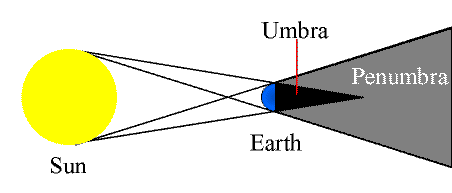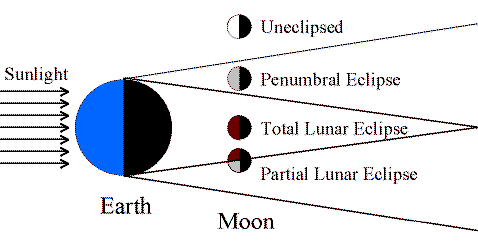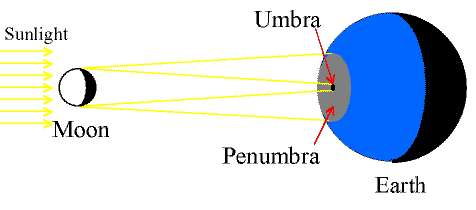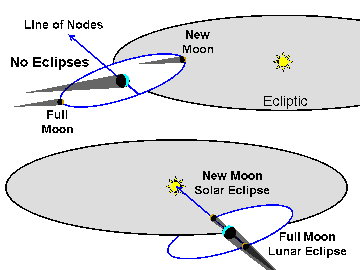Lecture 9: Eclipses of the Sun & Moon
Key Ideas:
Lunar Eclipses
- Moon passes through the Earth's shadow
- Total, Partial, & Penumbral lunar eclipses
Solar Eclipses
- Earth passes through the Moon's shadow
- Total, Partial, & Annular solar eclipses
The Eclipse Year
- How often do eclipses occur?
Umbra and Penumbra
Because the Sun appears as a disk ~1/2° across, Sun shadows are
fuzzy rather than sharp.
This means shadows cast by the Earth & Moon are two-part shadows:

(Click on the image to view at full scale [Size: 10Kb])
- Umbra: Inner core of total darkness
- The disc of the Sun is completely blocked.
-
- Penumbra: Outer, partial shadow
- Sun's disc is only partly blocked, with a bit peeking over the edge.
Lunar Eclipses
Lunar Eclipses occur when the Moon passes through the shadow of the
Earth.
They only occur during Full Moon when the Earth is between the
Moon and the Sun.
The Earth's umbra is ~1.4 Million km long:
- About 3.7x the mean Earth-Moon distance.
- Umbra's width is 9000 km at the distance of the
Moon, or ~2.6x the Moon's diameter.
The Earth's umbra is not totally dark because of light scattered by the
Earth's transparent atmosphere. This gives the fully eclipsed Moon a
slightly ruddy appearance (think about how the Sun looks reddish at
sunset or sunrise).
Three Types of Lunar Eclipses

(Click on the image to view at full scale [Size: 10Kb])
Total Lunar Eclipse:
- Entire Moon is within the Earth's umbra.
- Can spend up to 1h 40m in the umbra
- Whole show can last ~6 hours
Partial Lunar Eclipse:
- Only part of the Moon enters the umbra.
Penumbral Eclipse:
- Moon misses the umbra completely, only passes through
the penumbral shadow.
Because the Moon can be completely immersed in the Earth's umbra during
a total lunar eclipse, these eclipses can be seen from the entire
night-time hemisphere. This is in contrast to total solar eclipses as
we'll see below.
Solar Eclipses
Solar Eclipses occur when the Earth passes through the shadow of the
Moon.
Solar Eclipses only occur during New Moon, when the Moon is
between the Earth and the Sun.
The Moon's umbra is only 380,000 km long:
- Just long enough for the tip to touch the Earth.
- But not large enough to cover the entire Earth.
Solar Eclipses can be seen only where the shadow passes overhead.
Types of Solar Eclipses

(Click on the image to view at full scale [Size: 10Kb])
Total Solar Eclipse:
- The observer is inside the Moon's umbra.
- The Moon completely covers the Sun.
Partial Solar Eclipse:
- The observer is inside the Moon's penumbra.
- Only see part of the Sun covered by the Moon.
Annular Eclipse:
- The Moon is at or near apogee, and so is too small to cover the Sun.
- The Moon's umbra does not touch the Earth, so observer's in the
shadow path see the Sun as a ring ("annulus").
Total Solar Eclipses
Total Solar Eclipses are localized and short:
- The Moon's umbral shadow is at most 267 km across on the Earth.
- Totality lasts at most about 7.5 minutes, with the shadow
sweeping rapidly west-to-east.
- Only observers in the umbra see a total solar eclipse.
- Observers in the penumbra see a partial solar eclipse.
- Everyone else sees nothing.
While we often sketch the penumbra as uniform, in reality the penumbra
shades gradually from the completely dark umbra out towards the edges.
The reason is simple: as you move outwards away from the edge of the
umbra, you will see an increasing fraction of the Sun peeking out from
behind the Moon. There is a very nice Mir image of the 1999 Aug 11 eclipse
shadow showing what I mean.
Why are eclipses rare?
If the Moon's orbit were exactly aligned with the Ecliptic, we would see
- A solar eclipse every New Moon
- A lunar eclipse every Full Moon
But, this clearly does not happen. Why?
- The moon's orbit is tilted ~5° from the Ecliptic.
- Where the moon's orbit crosses the Ecliptic defines the
"Line of Nodes"
Eclipses only occur when the line of nodes and the Sun line up during
Full Moon or New Moon.

(Click on the image to view at full scale [Size: 9Kb])
Eclipse Year
The Line of Nodes align with the Sun every 346.6 days. This is called
the "Eclipse Year".
But, it must be a Full or New Moon when the nodes line up
to have an eclipse. This happens only very rarely.
From a given location on the Earth you see
- a Total Lunar Eclipse every 3 years (or so).
- a Total Solar Eclipse every 360 years.
Upcoming Eclipses
Updated: 2010 June 3
- Next Total Lunar Eclipse:
- 2010 December 21, visible from all of North America
- Next Total Solar Eclipse:
- 2010 July 11, visible from the south pacific (barely touches
South America)
- Next Total Solar Eclipse near Columbus:
- 2017 August 21, totality crosses through southern Illinois and
western Kentucky
(Google Maps view).
- Note that I define "near" to be within a day's drive of Columbus, OH.
- The next Total Solar Eclipse visible from Columbus proper will be on
2099 Sept 14 (Google Maps view). Eclipse duration will be about
4 minutes in Columbus. Tell your great-grandkids...
A great source of information on upcoming eclipses (and eclipses in
general) is Fred Espenak's
Eclipse Home Page at the NASA
Goddard Space Flight Center.
Return to [
Unit 2 Index
|
Astronomy 161 Main Page
]
Updated: 2010 June 3
Copyright © Richard W. Pogge, All Rights
Reserved.



